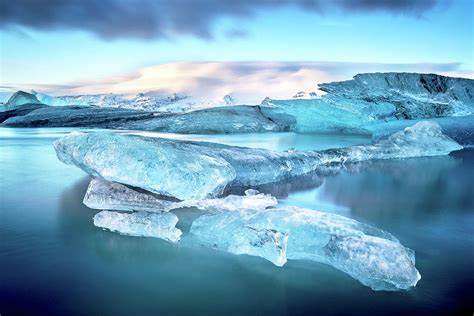Drifting sheets of ice are not just a spectacle of nature; they are a potent symbol of the dynamic and often unpredictable forces shaping our planet. These massive, floating expanses of frozen water are more than just picturesque landscapes—they are critical components of the Earth’s climate system. However, in recent years, the phenomenon of drifting ice sheets has gained attention, not just for its natural beauty, but for the alarming changes it signifies in the context of global climate change.
The Formation and Movement of Ice Sheets
Ice sheets are large masses of glacial ice and snow that extend over thousands of square kilometers, predominantly found in Greenland and Antarctica. They form over centuries as layers of snow accumulate, compress, and turn into ice. This slow process creates some of the largest and oldest natural structures on Earth, with some ice sheets being over a million years old.
Drifting occurs when sections of these ice sheets break away and float on the ocean’s surface. The movement of these ice sheets is influenced by various factors, including ocean currents, wind, and temperature fluctuations. In some cases, these sheets can travel vast distances, drifting across the ocean until they eventually melt or collide with other landmasses.
The Science Behind Drifting Ice Sheets
Understanding the behavior of drifting ice sheets requires a grasp of complex scientific principles. The movement of ice sheets is largely driven by the forces acting on them. Ocean currents and wind can push these sheets in different directions, while temperature changes can cause the ice to expand, contract, or break apart. The melting of ice sheets is particularly significant, as it contributes to rising sea levels—a major concern in the context of global warming.
One of the critical aspects of studying drifting ice sheets is monitoring their size and movement. Advances in satellite technology have allowed scientists to track these ice sheets with unprecedented accuracy, providing valuable data on their dynamics. This information is crucial for predicting the potential impacts of ice sheet drift on global sea levels and the broader climate system.
The Role of Ice Sheets in the Global Climate System
Ice sheets play a vital role in regulating the Earth’s climate. They reflect a significant amount of sunlight back into space, helping to keep the planet cool. When these sheets melt or drift into warmer waters, this reflective capacity is reduced, leading to further warming—a process known as the albedo effect. This creates a feedback loop, where warming leads to more ice melt, which in turn leads to further warming.
The loss of ice sheets also contributes to sea-level rise. As ice sheets melt, they release vast amounts of freshwater into the ocean, causing sea levels to rise. This has serious implications for coastal communities around the world, many of which are already experiencing the effects of rising seas, such as increased flooding and erosion.
The Impact of Climate Change on Drifting Ice Sheets
Climate change has significantly altered the behavior of drifting ice sheets. Warmer temperatures are causing ice sheets to melt more rapidly, leading to increased calving events, where large sections of ice break off and drift away. In some regions, the rate of ice loss has doubled in the past few decades, highlighting the urgent need for action to mitigate the effects of climate change.
The Antarctic and Greenland ice sheets are particularly vulnerable. In Antarctica, the West Antarctic Ice Sheet is losing ice at an alarming rate, with some scientists warning that it could collapse entirely within the next few centuries. Such an event would lead to catastrophic sea-level rise, with devastating consequences for millions of people worldwide.
In Greenland, the situation is equally concerning. The Greenland Ice Sheet is the second-largest ice mass in the world, and its rapid melting is a significant contributor to global sea-level rise. Recent studies have shown that Greenland is losing ice seven times faster than it was in the 1990s, a trend that could lead to a significant increase in sea levels by the end of the century.
The Ecological Consequences of Drifting Ice Sheets
The drifting and melting of ice sheets also have profound ecological impacts. Many species, particularly in the polar regions, rely on ice sheets for their survival. For example, polar bears use ice sheets as platforms for hunting seals, their primary food source. As the ice diminishes, polar bears are forced to travel greater distances in search of food, leading to increased energy expenditure and a decline in their population.
Similarly, the loss of ice sheets affects marine ecosystems. As ice sheets melt, they release freshwater into the ocean, which can alter ocean currents and disrupt the delicate balance of marine ecosystems. This can lead to changes in the distribution of marine species, with some species thriving in the new conditions while others struggle to survive.
Human Impacts and Global Implications
The implications of drifting ice sheets extend far beyond the polar regions. The melting of these ice masses is a global issue, with potential consequences for millions of people. Rising sea levels, for example, threaten to displace populations in low-lying coastal areas, leading to what some experts predict could be one of the largest migrations in human history.
In addition to displacement, rising sea levels can also lead to the loss of valuable agricultural land, increased salinization of freshwater sources, and greater vulnerability to extreme weather events such as hurricanes and storm surges. The economic costs of these impacts are staggering, with some estimates suggesting that the global cost of sea-level rise could reach trillions of dollars by the end of the century.
The Need for Urgent Action
The changes observed in drifting ice sheets underscore the urgent need for global action to address climate change. Mitigating the effects of climate change will require a coordinated effort from governments, businesses, and individuals to reduce greenhouse gas emissions, transition to renewable energy sources, and implement policies that protect vulnerable ecosystems.
International agreements, such as the Paris Agreement, represent a critical step in this direction. However, achieving the goals set out in these agreements will require significant commitments and action from all parties involved. The fate of drifting ice sheets, and the broader impacts of climate change, depend on the choices we make today.
Conclusion
The drifting sheets of ice serve as a powerful reminder of the fragility of our planet’s climate system. While they are awe-inspiring in their beauty and scale, they also represent a looming threat that we cannot afford to ignore. The changes taking place in the polar regions are a clear indication that the impacts of climate change are already being felt, and they will only intensify if we fail to act.
As we move forward, it is crucial that we take heed of the warnings these drifting ice sheets present. By understanding the science behind their movement, recognizing their role in the global climate system, and acknowledging the far-reaching consequences of their decline, we can begin to take the necessary steps to protect our planet for future generations. The drifting sheets of ice are not just a natural phenomenon—they are a call to action, urging us to confront the challenges of climate change head-on before it’s too late.







